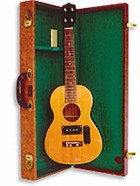
Ted McCarty, Gibson’s president from 1948 to ’66, was responsible for some of Gibson’s greatest designs. While McCarty cites the Les Paul Model as his most important design, his other credits include the ES-335, the Flying V, the McCarty pickup, and McCarty bridge.
But one design that never appears on McCarty’s list of accomplishments is his electric ukulele. In his time at Gibson, it was not unusual for a recording star to ask the factory to make a special instrument.
“People would call or visit us at the factory, and they’d say, ‘I’d like you to make me a special guitar, how much would it cost?’ We had a department that did nothing but make specials,” he said.
One person who contacted McCarty was radio and television icon Arthur Godfrey. As a sailor, Godfrey learned how to play the uke, and he brought that talent to his popular ’50s television show. But his uke couldn’t be heard with a band, some members of which were “plugged in,” and he wanted an electric that would match up with the electric guitar. So Godfrey went to McCarty.
“He wanted an electric ukulele, but he didn’t want electric strings,” he said. “He didn’t know if you could do that or not, so he finally asked me, and I said I’d try. I tried and I tried and finally got it, and it was good.”
Making an electric uke with nylon strings presented a real problem.
“I told my engineers what I wanted, and they built it. I had the problem of the strings, and that’s where I got involved. I designed what I wanted in the way of the strings. You can’t use regular nylon strings with an electromagnetic pickup, and Godfrey wouldn’t have anything to do with metal strings. He didn’t know any better, but that’s what he wanted. He was one of those guys who wants what he wants, and you better get it for him.
“So I talked with a couple of guys and nobody could come up with any ideas. They said, ‘You can’t do it, Ted!’ I said, ‘The hell you can’t.'”
So McCarty designed the strings himself.
“You have to get some iron in the strings somehow, and we couldn’t get a string inside a string and not get it too thick. So the only thing you could do was melt the nylon into a liquid, then run another string through a goo with iron powder. All you needed was some metal in the strings. The way I did it was to get some plastic string material so I could melt it and get it into a liquid. I put in fine iron-powdered metal and mixed it all up really well. I ran the strings through that, and after they dried we milled them down to size. I made the strings, but didn’t want to fool around with (mass-producing) them. It was time-consuming and expensive.”
The process took time, and Godfrey was impatient.
“He wanted to know where his ukulele was, and I said, ‘Well, we’re working on it.’ So I got it finished and we sent it to the hotel where he stayed in New York. And he called me and said, ‘Where is it?’ I said, ‘I sent it!’
“Well, he got on the air and said, ‘Ted McCarty – that used-to-be friend of mine – he promised to give me an electric ukulele, and we never got it!’
“I finally got so tired of him talking about me on the air that I called him and said, ‘It must be in the hotel because we sent it, and we have the credit for having shipped it.’ So he went and talked to them, and sure enough it was there, they just put it away.
“I heard he was overjoyed with it. And every time he was on the air, he used to do the cigarette ads (playing live music with his electric uke and the studio musicians), and Mr. Berlin (McCarty’s boss at CMI, Gibson’s parent company) and I would sit together in Mr. Berlin’s office and listen to Godfrey’s program. And Godfrey would say, ‘My friend, Ted McCarty from Gibson, and so forth and so forth,’ everyday. And Mr. Berlin used to laugh and say, ‘You and I made more air time for free than the cigarette company was getting.'”
Another interesting fact is that McCarty actually made two electric ukes. The second was set up with guitar strings and a P-90 pickup. He still has it, and it’s in mint condition.
“You can’t just make one of something, it’s very difficult. But after we designed it, we never produced them. At the retail price, nobody would have bought it.”
The only standard-sized uke listed in the 1957 Gibson Price List was the Uke-1, at $30.
The Gibson electric uke McCarty kept for himself has an early P-90 variant and two control knobs. Photo: Gil Hembree.
This article originally appeared in VG‘s April ’00 issue. All copyrights are by the author and Vintage Guitar magazine. Unauthorized replication or use is strictly prohibited.


